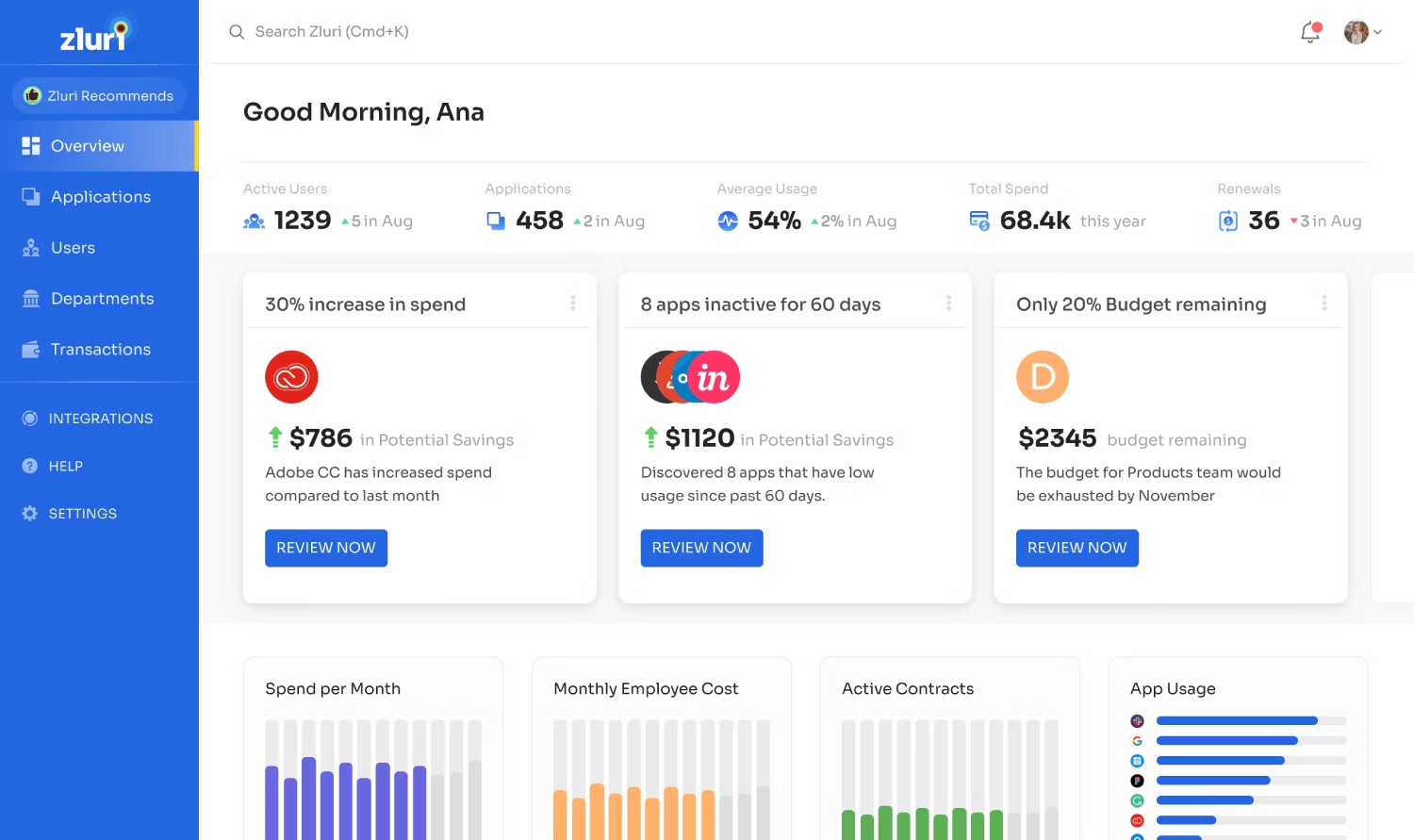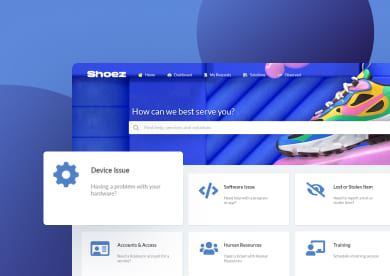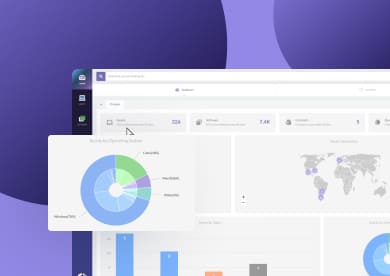SaaS Management is becoming a top priority for organizations. According to a 2025 report, the average organization uses 106 SaaS applications (only slightly down from 112 the previous year). While that suggests some cleanup, it still leaves a large, complex stack that’s often decentralized and hard to control.
This environment creates risks: wasted spend, security gaps, compliance issues, and tool duplication. SaaS Management helps teams take back control. In this guide, we’ll explain what it is, what platforms offer, and how to choose the right one to manage your SaaS stack effectively.
What is SaaS Management?
SaaS Management is the practice of tracking, controlling, and optimizing all the cloud-based software used within an organization. As teams adopt more tools independently, it becomes harder to know what’s being used, who’s using it, and whether it’s secure or cost-effective.
This process helps companies gain full visibility over their SaaS stack, cut unnecessary spending, reduce security risks, and stay compliant with licensing and data regulations. In short, it’s how organizations take back control of their software environment.
What is a SaaS Management platform?
A SaaS Management platform (SMP) is a tool designed to help organizations discover, monitor, and manage all their SaaS applications from one place. It centralizes information about usage, costs, licenses, and user access, giving teams the visibility they need to act.
Instead of relying on spreadsheets or manual tracking, these platforms automatically detect which apps are in use, who’s using them, and how often. This allows teams to make smarter decisions, reduce waste, prevent shadow IT, and stay ahead of renewals and compliance tasks.
Main features of SaaS Management platforms
SaaS Management platforms bring structure and automation to a growing, often chaotic environment of cloud apps. To truly regain control, reduce waste, and improve security, a solid platform should offer the following capabilities:
- Application discovery – Automatically detects all SaaS apps in use, including those outside IT’s radar, using integrations, browser plugins, and network activity.
- Usage insights – Tracks how each app is used, how often, and by whom — helping identify underused tools and potential savings.
- License and User Management – Lets you assign, revoke, or reallocate licenses based on real usage. This also helps manage onboarding and offboarding efficiently.
- Cost optimization – Combines usage and spend data to highlight redundant apps, unused licenses, or overpriced plans.
- Renewal tracking – Centralizes subscription details and sends alerts before auto-renewals hit, so you can negotiate better terms or cancel unused services.
- Security and compliance monitoring – Flags unauthorized or risky apps, manages user permissions, and helps enforce regulatory standards (like GDPR, SOC 2, or HIPAA).
- Vendor and Contract Management – Keeps track of SaaS vendors, contracts, terms, and access rights to simplify audits and avoid surprises.
- Integrations – Connects with your existing tools to provide a complete view of your SaaS ecosystem.
Best 6 SaaS Management Platforms in 2025
1. InvGate Asset Management

InvGate Asset Management is an IT Asset Management (ITAM) solution with strong SaaS Management capabilities. Designed to centralize oversight, it allows teams to monitor the entire lifecycle of IT assets (including cloud-based applications) from a single, modern platform.
Trusted by KPMG, NASA, PwC, and Arcos Dorados, InvGate Asset Management is a no-code platform with a clean, modern interface that’s easy to use for both technical and non-technical teams. Its flexible pricing scales with your organization, making it accessible at any stage of growth.
InvGate Asset Management features
- Automatic SaaS discovery – Identifies cloud applications in use across the organization through integrations, agentless scans, and the InvGate agent.
- License tracking and optimization – Helps track license usage, reassign licenses based on usage, and detect underutilized tools.
- Contract and Subscription Management – Centralizes all SaaS vendor information, renewal dates, and payment terms to prevent surprises.
- Renewal alerts and workflows – Triggers reminders and tasks for upcoming SaaS renewals to support better vendor negotiations.
- Dashboards and custom reports – Visualizes app usage, spend, and license metrics to support informed decisions.
- Native integration with InvGate Service Management – Enables automation between SaaS inventory and IT support workflows.
InvGate Asset Management pros
- Multiple deployment options: offers both cloud and on-premise deployment options, adaptable to different IT policies and regulations.
- Modern and intuitive UI: ideal for organizations looking to avoid complex setups or steep learning curves.
- Automation and AI-Hub: Built-in automation and reporting tools reduce manual overhead, and AI features help identify optimization opportunities, surface insights, and streamline decision-making.
- Various integrations: comes with a wide range of integrations, including SSO providers, remote desktop, and collaboration platforms.
- Native connection with InvGate Service Management enhances SaaS-related workflows (access requests, onboarding, etc.).
InvGate Asset Management comments and reviews
InvGate Asset Management is rated 4.4 stars on Gartner Peer Insights, within the Software Asset Management category.
“Invgate Asset Management is an excellent tool for IT departments. It allows you to have a complete overview of all technological and manual assets of the company. Provides a site which can contain all the software contracts for all the company devices and much more.”
Sales manager, Gartner Peer Insights
Users highlight the platform’s usability, integration variety, and flexible deployment options as key differentiators.
InvGate Asset Management pricing
InvGate Asset Management uses a per-node subscription pricing model, with three flexible plans:
- Starter Plan: For small organizations, covers up to 500 nodes at $0.21 per node per month ($1,250 billed annually).
- Pro Plan: The most popular option for mid-sized businesses, supports 501-10,000 nodes at $0.38 per node per month (billed annually).
- Enterprise Plan: Tailored for large enterprises with custom node requirements. Contact sales for pricing.
All plans are billed annually, and a 30-day free trial is available — no credit card required.
#2: Zluri
Zluri is a Identity Governance and Administration (IGA) platform that helps organizations manage their SaaS stacks end-to-end (from discovery and optimization to access governance and renewal planning). It provides a unified console for visibility and control across cloud applications.
Zluri features
- Automated app discovery with browser agents, desktop connectors, and integrations to uncover both sanctioned and shadow SaaS usage.
- Usage tracking & cost optimization to map spend and highlight unused licenses.
- Access reviews & provisioning workflows to automate onboarding/offboarding in line with identity and HR systems.
- Contract & Renewal Management that centralizes subscriptions and alerts before renewals .
- Security & compliance monitoring, including policy enforcement, multi-factor authentication support, and threat alerting.
- Strong integration ecosystem, with over 300 connectors to IdPs, HRIS, ITSM systems, and SaaS apps.
Zluri pros
- User-friendly UI praised for easy navigation and setup.
- Comprehensive integrations backed by fast onboarding support .
- Robust automation and reporting.
- Well-regarded support team, known for swift responses and quality assistance.
Zluri cons
- Browser agent limitations: requires separate Chrome profile and desktop agent — users wish for unified capture.
- Occasional data inaccuracies during audits.
- Learning curve for advanced automation — takes time to customize workflows fully.
- Coverage not universal — some niche SaaS apps may not be supported initially.
Zluri comments and reviews
Zluri is rated 4.8 stars on G2, based on verified user reviews in the SaaS Management category.
"The renewal alerts and the visibility over the SaaS ecosystem are what I love the most. It used to feel like getting locked into a vendor when an application auto-renews without our notice."
Vinoth K., Capterra reviews
Users frequently highlight its ease of use, wide integration coverage, and strong support team as key advantages.
Zluri pricing
Zluri offers both SaaS and optional on-premise deployment. Exact pricing requires contacting Zluri directly.
#3: Torii
 Torii is a cloud-native SaaS Management Platform that empowers organizations to manage their entire SaaS stack (from discovery to spend optimization and access governance).
Torii is a cloud-native SaaS Management Platform that empowers organizations to manage their entire SaaS stack (from discovery to spend optimization and access governance).
Torii features
- Automated app discovery via browser connectors, SSO, and desktop agents to capture both sanctioned and shadow IT.
- Usage insight & cost management that reveals license utilization and redundant apps for optimization.
- Onboarding/offboarding automation, creating audit-ready access workflows and alerts.
- Contract & renewal tracking, centralizing subscriptions and sending proactive reminders.
- Threat alerting & policy enforcement to control risky usage and support regulatory compliance.
- Open integration ecosystem, with strong support for IdPs, HR systems, ITSM, and productivity platforms.
Torii pros
- Deep automation capabilities, praised for robust workflows and proactive alerts.
- Outstanding spend optimization, ranked #1 in SaaS spend management on G2.
Torii cons
- Premium pricing: Some users report hidden costs and that pricing may be steep for smaller teams .
- Workflow customization limitations: Reordering tasks can be cumbersome in complex scenarios.
- Incomplete coverage for niche apps: Requires manual inclusion for some lesser-known tools.
- Browser-based detection constraints: Effectiveness depends on users signing in via tracked profiles.
Torii comments and reviews
Torii earns 4.5 stars on G2, with users praising its setup simplicity, powerful insights, and responsive support.
“Some features were missing when we started using Torii. Yet all my request were already on Torii's roadmap, some have already been implemented.”
Avshi A, Capterra reviews
Users note that Torii often listens and acts on feedback, regularly updating features based on customer input.
Torii pricing
Torii offers three subscription-based pricing tiers, billed annually:
- Basic – $2.5 per employee/month (minimum $250/month). Includes browser extension and SSO visibility, unlimited integrations, expense reports, and license cost insights.
- Professional – Custom quote. Adds financial integrations, workflow automation, role-based access, and a dedicated success manager.
- Enterprise – Custom quote. Includes custom integrations, automatic recommendations, pricing benchmarks, chargeback & cost allocation, and prioritized support.
A free trial is available for the Basic plan.
#4: BetterCloud
 BetterCloud is a unified SaaS Management platform designed to help IT, Security, and SaaS operations teams automate App Lifecycle Management, secure environments, and optimize spend. The company, launched by pivoting from G Suite tools in 2015, is now recognized for managing a wide variety of SaaS services across enterprises .
BetterCloud is a unified SaaS Management platform designed to help IT, Security, and SaaS operations teams automate App Lifecycle Management, secure environments, and optimize spend. The company, launched by pivoting from G Suite tools in 2015, is now recognized for managing a wide variety of SaaS services across enterprises .
BetterCloud features
- Powerful workflow automation.
- App discovery and consolidation, highlighting shadow IT and redundant subscriptions.
- Access and compliance audits, supporting PII, GDPR, HIPAA monitoring, and automated policy enforcement.
- Spend tracking and optimization.
- Robust reporting and dashboards, offering custom insights into usage patterns, security risks, and cost trends.
- APIs and pre-built connectors, enabling integration with identity, ITSM, and security systems.
BetterCloud pros
- High automation capabilities.
- Strong compliance and security controls, with built-in policy checks across many regulations.
- Comprehensive spend analytics, linking usage data back to contracts for smart renewals.
- Well-rated in G2 and Gartner, with multi-category recognition and a 4.5/4.8 rating in adjacent security markets.
BetterCloud cons
- Steeper learning curve and setup complexity, especially for smaller IT teams.
- UI can be confusing, with hard-to-read fields and truncated labels.
- Integration gaps: Some niche apps and API connections may be missing.
- Premium pricing, which may be out of reach for startups or small organizations.
BetterCloud comments and reviews
BetterCloud holds a 4.5 rating on Gartner Peer Insights.
"I enjoy Bettercloud's ease of use and low barrier to entry. You can started with a handful of useful workflows almost immediately, and without much training."
Jordan R., Capterra reviews
BetterCloud pricing
Pricing for BetterCloud is subscription-based and quote-driven, tailored to the size and scope of your SaaS environment. For specific costs, you need to contact sales directly.
#5: SailPoint SaaS Management
 SailPoint SaaS Management is a solution from SailPoint Technologies, a market leader in Identity Governance and Administration. This tool provides visibility and control over SaaS apps, focusing on identity, access, and security governance. It meshes well with SailPoint’s core strengths—access provisioning and compliance enforcement across cloud environments.
SailPoint SaaS Management is a solution from SailPoint Technologies, a market leader in Identity Governance and Administration. This tool provides visibility and control over SaaS apps, focusing on identity, access, and security governance. It meshes well with SailPoint’s core strengths—access provisioning and compliance enforcement across cloud environments.
SailPoint features
- Comprehensive SaaS discovery to detect all cloud-based apps in use, including shadow IT.
- Access provisioning and lifecycle automation, integrating with identity systems to automate onboarding and offboarding.
- Security and compliance monitoring, with automated alerts for risky behavior and policy violations (e.g., PII, GDPR).
- Contract and renewal workflows to stay ahead of subscription renewals and license expiry.
- Dashboards and audit logs capture usage, access events, and compliance history for reporting needs.
- Robust integrations with directories, HR systems, ITSM tools, and enterprise apps.
SailPoint pros
- Strong identity governance with robust access control and policy enforcement.
- High quality of support, with a G2 score of 9.1 for support services.
- Highly scalable and secure architecture, preferred by large, regulated enterprises .
- Automates SaaS user lifecycle, reducing manual tasks and improving security hygiene.
SailPoint cons
- High cost, including licensing, deployment, and maintenance—may be prohibitive for smaller organizations.
- Steep learning curve and implementation complexity, often requiring technical expertise or consulting.
- Reporting and analytics limitations, users note reports are not as intuitive or flexible as desired.
- Customization and caching issues, leading to delays and occasional errors reported by users.
SailPoint comments and reviews
SailPoint SaaS Management holds a 4.4-star rating on G2 (15 reviews), and parent SailPoint Technologies is rated 4.7 stars across 654 reviews on Gartner Peer Insights.
“The overall experience with Sailpoint is fine, we did notice that the platform is starting to suffer from response delays and since we use the SaaS of IdentityNow it might seem that as more customers are being added the performance is being impacted.”
Verified user, Capterra reviews
SailPoint pricing
Pricing for SailPoint SaaS Management is custom and quote-based, reflecting enterprise-grade features and scalability.
Typical deployments involve enterprise-level licensing and professional services, meaning budget planning should account for implementation and ongoing support costs.
Key benefits of SaaS Management
The ideal time to begin thinking about SaaS Management is when your organization is handling multiple subscriptions across departments, leading to a lack of visibility, increased costs, and security risks.
Let’s explore the key benefits of adopting SaaS Management.
#1. Cost efficiency
Managing SaaS subscriptions manually can lead to overspending. Duplicate subscriptions, unused licenses, and auto-renewals are common issues. SaaS Management tools provide visibility into what your organization is paying for, helping you cut costs and optimize your IT budget.
By tracking usage and eliminating unused licenses, SaaS Management platforms ensure you pay only for what you use. Many platforms also offer insights into upcoming renewals, so you're never caught off guard.
#2. Streamlined operations
Without SaaS Management, different teams may use different tools for the same purpose, leading to inefficiencies and data silos. SaaS Management provides a centralized view of all tools, enabling businesses to standardize operations and eliminate redundant apps.
This leads to smoother workflows, better collaboration, and more consistent data across departments. It also ensures that the right tools are used for the right purposes, avoiding misalignment between teams.
#3. Improved security and compliance
As more SaaS applications are added, it becomes harder to maintain security and compliance standards. Each app introduces potential vulnerabilities, and without proper oversight, businesses can expose themselves to unnecessary risks.
SaaS Management platforms help ensure that only authorized users access tools, enforce data protection policies, and keep track of compliance regulations, especially for industries that handle sensitive information, like healthcare and finance.
#4. Better Vendor Management
Negotiating contracts, managing renewals, and understanding terms with multiple vendors can be a logistical nightmare. SaaS Management platforms offer Vendor Management capabilities that make it easier to handle all your software providers in one place.
From tracking contract terms to automatically alerting you about renewal dates, vendor management through a SaaS platform saves time and helps avoid costly contract mishaps.
#5. Enhanced usage analytics
Understanding how employees use your SaaS tools can reveal hidden opportunities for optimization. SaaS Management platforms offer detailed usage analytics, allowing you to see which tools are utilized most and where you might be overpaying for underused software.
These insights can help inform decisions on consolidating subscriptions, renegotiating contracts, or reallocating tools to those who need them most.
Where to start with SaaS Management?
The tipping point for implementing a SaaS Management solution is when your spreadsheets become a bottleneck rather than a helpful tool. If you’re spending more time managing licenses than using the software itself, it’s time to switch.
Signs to look for include escalating costs, growing numbers of subscriptions, and increased security concerns. At this point, investing in a SaaS Management platform can streamline operations and bring clarity to your software ecosystem.
What does a SaaS manager do?
A SaaS manager is responsible for overseeing all the SaaS tools within an organization. Their job includes ensuring that the company is making the most of its subscriptions, optimizing costs, and maintaining security standards.
SaaS managers play a crucial role in monitoring these costs, optimizing usage, and ensuring that every tool meets the company’s needs.
To sum up
The SaaS landscape is only getting more complex — and without proper management, it can quietly drain your budget, introduce security risks, and create operational silos. SaaS Management helps you flip the script by bringing visibility, control, and strategy to your software ecosystem.
The sooner you start managing your SaaS stack proactively, the more value you’ll extract from every subscription.















